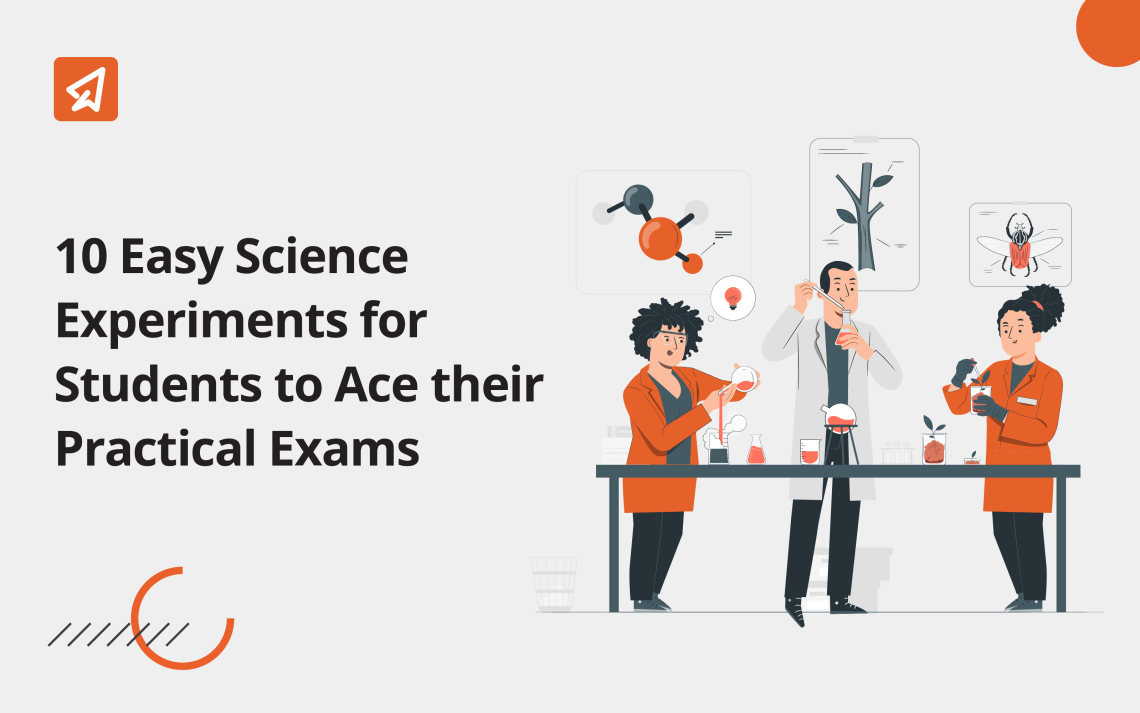10 Easy Science Experiments for Students to Ace their Practical Exams

Science is an integral part of our daily lives. From basic activities like cooking and painting to the gadgets we use – almost everything we do has applications of science. Consequently, science forms a natural and crucial part of children’s early learning. This is one subject area that helps them find answers to the greatest mysteries of the world. Thus, it is important to help kids develop an interest in science early on. One of the effective ways to do this is by conducting simple science experiments with them.
Easy Science Experiments for Students to Enjoy and Learn
Here is a detailed list of DIY science experiments designed for school-goers that will make them inquisitive and involved in the world of science.
DIY Science Experiment #1: Water Evaporation
This is an easy science experiment to do at home. Partly fill two transparent cups with equal amounts of water. Keep the water levels marked using a marker. Use a cling wrap to cover one of the cups and leave it aside for a few days. Kids can observe the levels each day and make note of the changes they witness. The water level of the cup without any cover reduces with each passing day. This is how they can learn about water evaporation.
DIY Science Experiment #2: Static Electricity with Hair Comb
In theory, we have all learned that rubbing some materials together generates electrical charges, or static electricity. Learn its application by running a plastic comb through your hair multiple times. This establishes a negative static charge on the comb. Then place the comb close to small bits of paper. The charged comb creates an opposite charge and attracts these pieces of paper. This simple science experiment only takes a few minutes, but the outcome will make you want to do it again and again.
DIY Science Experiment #3: Light Refraction
This easy science experiment is a fun way to demonstrate the science of light. On a sheet of paper, draw two big arrows pointing towards the same direction; but one at the top and one at the bottom. Then, fill a glass with water and place the piece of paper behind it. Students can look through the glass and they will notice an arrow changing its direction instantly. Here, the water refracts the light passing through it. That means, water acts as a magnifying lens and makes the light bend when it travels through the cup into the water. The light bends again as it travels from the cup into the air, making the image seem to be flipped horizontally.
DIY Science Experiment #4: Elephant Toothpaste
With a handful of ingredients, it is possible to create a large foaming reaction flowing out of a tube. Take an empty plastic bottle, warm water, dry yeast, hydrogen peroxide (3%), liquid dish soap, and a wide tray or bucket. Pour these ingredients into the bottle with a few drops of food color, and then take a step back. The kids will notice the giant foam oozing out of the bottle, which looks like toothpaste – big enough for an elephant.
DIY Science Experiment #5: Sound Waves
For those kids who want to do an easy science experiment at home, this is the right one! They can have fun with their DIY musical instruments using glass jars and water, and discover the science of sound waves. The only effort needed is to fill these jars with different levels of colored water. With the help of a spoon, tap them to hear different sounds. The differing water levels will produce different tones and vibrations.
DIY Science Experiment #6: Dancing Raisins
Will the raisins float or sink? This is a fun and simple science experiment that students can perform with an ingredient that is easily available at home. Fill one glass with water and the other with clear soda. Add a few raisins to each glass. The gas bubbles from the glass with soda push the raisins upwards. Once the carbon dioxide bubbles touch the surface, they pop, and the raisins sink again. Before conducting this experiment, separate the raisins, because if they are stuck together, they will not float.
DIY Science Experiment #7: Plant Transpiration
Any open space in your house is an excellent place to conduct DIY science experiments. This transpiration experiment will help you learn how plants lose water to air. Take a potted plant and water it sufficiently. Place the plant on a glass plate and cover it with a see-through bell jar. Expose this apparatus to sunlight for two to three hours and observe. You will notice a few droplets of water on the inner side of the jar. Transpiration occurs when potted plants release water into the air in the form of water droplets or vapor.
DIY Science Experiment #8: Oil and Water Exploration
The following easy science experiment includes mixing equal parts water and oil with a few drops of food color. Mix it with a stirrer until the food color dissolves and breaks into tiny bubbles. The food color blends with water but not oil. Since oil is less dense than water, it floats at the top. Using these regular kitchen items, kids can learn what happens when two liquids with different densities are mixed together. They can try variations by using multiple colors and different glass sizes.
DIY Science Experiment #9: Make a Cloud in a Jar
As part of our environmental studies, we all learn about clouds at some point or the other. But ever tried forming clouds practically? For this DIY science experiment, you will need a jar filled with hot water, a bottle of hairspray, and some ice cubes. Swirl the jar and turn the lid upside down. Place the ice cubes on the lid and set it aside for a few seconds. Then, remove the lid, spray some hairspray in the jar, and cover it again with the lid and ice. You will notice the cloud forming in the jar. This is a great activity to learn about the water cycle and how clouds are formed.
DIY Science Experiment #10: Balloon Blow-Up
This simple science experiment shows how physical states of matter change when liquids and solids are mixed to create gas. Kids can perform this experiment by scooping some baking soda in a balloon and vinegar in a flask. Attach the balloon to the top of the flask and allow the vinegar to come in contact with baking soda. This creates a chemical reaction in the form of gas, which inflates the balloon.
How Extramarks Can Help Students Excel in Science Practicals
Science, as a subject, forms an important part of the school curriculum from the very beginning. Thus, students are expected to develop practical skills throughout their schooling. This is possible by attending and performing regular practical sessions along with theoretical learning. Here is where Extramarks Learning App can come into play and provide students with resources for deeper learning and development of skills. Using our wide ranging online study material and practice tests, school-goers can build their curiosity, as well as proficiency in science.
Explore Science – One Experiment at a Time
There you have it! These 10 easy science experiments will inspire the little scientist in you and help you learn the applications of some of the concepts in science education. Bookmark this detailed guide and save it for a rainy day.
FAQs
1. What are some easy science experiments to do at home?
Most of these experiments can be performed at home. The easiest ones include the dancing raisins experiment, oil and water experiment, and plant transpiration.
2. Why is it important to learn from science experiments?
Science experiments are important because they provide opportunities to learn about the earth and universe. Students get a chance to develop skills like decision-making, observation, problem-solving, and data analysis.
3. Can young children perform science experiments?
Yes, young kids can do science experiments under the supervision of a parent or teacher. Introducing science at a young age assists with brain development.
4. Why does a conclusion for a science experiment matter?
A strong conclusion is important because it contains a description of the objective of the experiment. It also acts as a source to present your findings and offer recommendations for further study.
5. What is the significance of a science experiment to a theory?
Science experiments serve to test theories and provide the foundation for scientific knowledge.
Last Updated on April 16, 2025










